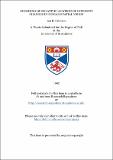Files in this item
Encoding of relative location of intensity changes in human spatial vision
Item metadata
| dc.contributor.author | Paterson, Ian R. | |
| dc.coverage.spatial | [ca 280] p. | en_US |
| dc.date.accessioned | 2018-06-26T10:27:38Z | |
| dc.date.available | 2018-06-26T10:27:38Z | |
| dc.date.issued | 1992 | |
| dc.identifier.uri | https://hdl.handle.net/10023/14594 | |
| dc.description.abstract | The psychophysical experiments and numerical modelling reported in the present study are an investigation into the encoding of relative location of intensity changes in the human visual system. The study attempted, successfully, to explain some geometric illusions resulting from closely spaced image features ('crowding'), and determined the nature of information necessary for making judgments about the separation of intensity changes for different stimulus configurations. Experiments performed fell into two basic categories; those concerned with spatial interference, and studies of spatial interval judgments. The first set of experiments, studying spatial interference with relative localisation for intensity changes, was based on measurements made with stimuli composed of lowpass filtered bars and edges. The most successful model, which accounted for all of the data, was Watt and Morgan's (1984, 1985) MIRAGE; the results suggest that a good explanation of some geometric illusions can be derived using the principles of low-level vision. Spatial interference is strong evidence for combination of information across spatial scales, and the MIRAGE algorithm makes some highly accurate predictions. Relating the separation of image features is a fundamental task for the visual system, but there is no clear understanding of what information the system has available to perform this task. The second set of experiments explored the perception of separation, and precision of judgments of separation, for bars with a variety of orthoaxial contrast profiles. The data indicate that information is combined across spatial scales (as in MIRAGE) under certain circumstances in making separation judgments; this combination of information across scale occurs when the information on the scales combined is in agreement (ie. all scales have some task-related information), but when variance is added on coarser scales which is not relevant to the task, the system is capable of selecting the finest scales of filters available, and using only the information in the finest scale. This adaptive scale-selection process operates even at very brief exposure durations. | en_US |
| dc.language.iso | en | en_US |
| dc.publisher | University of St Andrews | |
| dc.subject.lcc | QP491.P2 | |
| dc.subject.lcsh | Space perception--Physiological aspects | en |
| dc.title | Encoding of relative location of intensity changes in human spatial vision | en_US |
| dc.type | Thesis | en_US |
| dc.type.qualificationlevel | Doctoral | en_US |
| dc.type.qualificationname | PhD Doctor of Philosophy | en_US |
| dc.publisher.institution | The University of St Andrews | en_US |
This item appears in the following Collection(s)
Items in the St Andrews Research Repository are protected by copyright, with all rights reserved, unless otherwise indicated.

